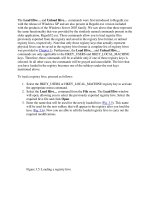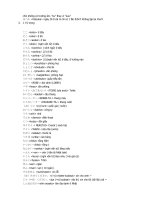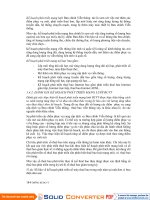The Sky at Night Phần 2 pps
Bạn đang xem bản rút gọn của tài liệu. Xem và tải ngay bản đầy đủ của tài liệu tại đây (2.3 MB, 19 trang )
31 Eye on the Universe
the telescope really excelled. The images of clusters, nebulae and galaxies are the
best ever taken. Also, pictures sent back of the remotest galaxies within range showed
that we were looking back at the very early history of the universe.
In every way, the Hubble Space Telescope has been an astounding success – and
remember, it has cost less then a nuclear submarine! Originally, it was planned to
operate for 15 years, and this it has now done, but all the time it is sending back
new data, and to lose it would be a scientific disaster. Moreover, no replacement can
be sent up before 2012 at the earliest, and probably not for some years after that.
The planned James Webb Space Telescope will be larger than Hubble, but will
concentrate upon infra-red research. Unlike Hubble it will not orbit the Earth. It
will be sent to one of the “Langrangian points”, a position near the Earth’s orbit
which is stable. It will be well away from any terrestrial interference, but it will be
a million miles away from us, and no servicing missions will be possible so that the
designers must do their best to get everything right first time!
Whatever happens, Hubble will continue to work for several years yet. It was at
first planned to bring it back to Earth without damaging it. When this was deemed
to be too difficult, there was a proposal to boost it into a higher orbit above all the
resting part of the atmosphere, and simply leave it there until we developed techniques
to make it possible to fish down. Now alas, there is a serious proposal to de-orbit it
and allow it to burn away as it comes down. There are dangers here too, because it
is a relatively massive structure, and it could well fall into an inhabited area. I know
that all astronomers – and indeed all non astronomers, too – would be sad to see us
destroying one of our very best achievements. Let us hope this does not happen.
The threat seemed imminent in 2005, when our programme was transmitted, but
receded when NASA changed its mind and authorised a further servicing mission.
So HST is safe for the moment; it cannot remain aloft forever, but it is a vital part
of scientific history, and it will never be forgotten.
5
P. Moore, The Sky at Night, DOI 10.1007/978-1-4419-6409-0_2,
© Springer Science+Business Media, LLC 2010
It had been some time since a programme had been devoted entirely to the Sun, and
it seemed that one now would be appropriate. For this, I was joined by Professor
John Brown (the Astronomer Royal for Scotland), Dr Lyndsay Fletcher of Glasgow
university and (from La Palma in the Canary islands) Dr Goran Scharmer, who
talked to Chris Lintott. In my garden, outside my observatory dome, were Keith
Johnson, Alan Clitherow, Ninian Boyle and others, suitably equipped with telescopes.
As usual, the Selsey weather was kind.
Chapter 2
The Turbulent Sun
The Sun (SOHO)
6 2 The Turbulent Sun
To us, the Sun is the most splendid object in the sky; it is all-important, and
without it the Earth would not have been born. True, it is only a normal star – 1 of
100,000 million in our Galaxy – but it is the only star close enough to be studied in
detail; it is a mere 93 million miles away, and light from it can reach us in only
8.6 min. Light from the nearest star beyond the Sun, Proxima Centauri, takes over
4 years to reach us. Represent the Earth–Sun distance by one inch, and Proxima
will be over 4 miles away.
The Sun is large; its diameter is around 865,000 miles, and it could hold over a
million bodies, the volume of the Earth. It is also very hot. At its surface the temperature
is not less than 6,000°, and at its core a thermometer would register about 15 million
degrees – assuming that a thermometer could survive there!
The Sun is a gaseous throughout. It is not burning in the conventional sense;
a Sun made up of coal and radiating as fiercely as the Sun actually does would turn
to ashes in a million years or so. But we know that the age of the Earth is
4,600,000,000 years, and the Sun is certainly older than that. According to modern
theory, it was formed from a cloud of dust and gas inside a nebula 5,000 million
years ago, and it will be another 5,000 million years before anything dramatic happens
to it so that by cosmological standards, it is no more than middle-aged.
The core is the Sun’s power house, where its energy is being created. It contains
a vast amount of hydrogen, which is the most plentiful element in the universe
(atoms, of hydrogen outnumber the numbers of all other elements combined). At
the core, where the temperature and pressure are so high, the nuclei of hydrogen
atoms are combining to make up nuclei of another element, helium. It takes four
hydrogen nuclei to form one helium nucleus; every time this happens, a little
energy is set free and a little mass is lost. It is this liberated energy that makes
the Sun shine, and the mass-lost amounts to four million tons per second so that the
Sun now “weighs” much less than it did when you began to read this page.
However, please do not be alarmed – there is plenty of hydrogen fuel left. To
quote Corporal Jones, “Don’t panic!”
The Sun’s bright surface is known as the photosphere. It is not as placid as it may
seem; it shows granular structure, and very often there are dark patches known as
sunspots. The spots are huge by terrestrial standards, but are not permanent; even
large spots-groups seldom last for more than a few weeks or months. Neither is then
in view continuously. The Sun is spinning on its axis, taking an average of 28 days
to complete one turn so that a spot will be carried slowly across the disk until it
passes over the limb. A fortnight or so later, it will reappear at the opposite limb,
provided that it still exists. Spots generally appear in groups, though single spots
are not uncommon; some spots are regular in shape, others irregular. A regular spot
will have a dark central “Umbra”, surrounded by a lighter “Penumbra”. Many
Umbrae may be contained in one penumbral mass; a typical group has two main
spots, a leader and a follower.
Sunspots are essentially magnetic phenomena. Lines of magnetic force run below
the solar surface; when they break through the photosphere they cool it down, and
a sunspot is the result. In fact a spot is not really dark; It appears so only because it
is around 2,000° cooler than its surroundings. If it could be seen shining on its own,
72 The Turbulent Sun
its surface brightness would be greater than that of an arc-lamp. Spots are usually
associated with brilliant, high attitude clouds known as faculae (Latin, torches).
A word of warning here: Solar observing can be dangerous, and to look straight
at the Sun through any telescope or binoculars will result in eye damage – perhaps
blindness – unless careful precautions are taken. Fitting a dark filter over the telescope
eyepiece is not recommended for the newcomer; filters may not give full protection
and are liable to splinter without warning. Mylar filters can be used – but make sure
you know exactly what you are doing. To use the telescope as a projector and send
the Sun’s image on to a card held or fixed behind the eye piece is far better. In
general, a refracting telescope is better than a reflector for solar work. Remember,
too, that the Sun is still dangerous when it is low in the sky, veiled by haze, and
looks deceptively mild and harmless. A moment’s carelessness may have tragic
results, and, sadly, accidents of this kind have happened in the past. (Some small,
cheap telescopes are sold together with dark “Sun caps” for direct viewing. If you
have one of these caps, throw it away.)
Above the photosphere comes the layer known as the chromosphere, and
above the chromosphere we come to the corona, made up of very tenuous gas.
Normally, the chromosphere and the corona cannot be seen with the naked eye,
or with a straightforward telescope; we have to wait for a total solar eclipse when
the Moon passes directly in front of the Sun and obligingly blocks out the photo-
sphere for a brief period (never as long as eight minutes and usually much less).
Unfortunately, total eclipses are rare as seen from any particular location, and
generally we have to depend upon instruments based upon the principal of the
spectroscope. Consider flares, for example, which occur in the chromosphere,
and are immensely energetic. Very few have been observed with ordinary tele-
scopes; the first was seen in 1859 by one of the great pioneer solar observers,
Richard Carrington. I have never seen one myself.
A flare begins in the lower chromosphere; it rises upwards, sending out charged
particles that cross the 93,000,000-mile gap and reach the Earth, meeting the top of
the atmosphere and causing the lovely aurorae or polar lights as well as causing
magnetic storms and interfering with radio communication. Flares are usually (not
always) associated with spot-groups, which means that they are commonest when
the Sun is most active. Equipment now is less expensive than it used to be; for
example, the serious solar observer will need a telescope design to cut out all light
except that from, say, incandescent hydrogen. If you can afford £400, you can set
up a proper solar observing station. This may sound a large sum – until you compare
it with a new laptop or a couple of railway tickets between London and Glasgow!
There are also phenomena such as Coronal Mass Ejections (CMEs), when huge
quantities of gas are sent out, never to fall back into the Sun.
There is a reasonably well-defined solar cycle with a mean period of 11 years;
at maximum, many spot-groups may be on view at the same time, while at minimum
the disk may be clear for several consecutive days or even a week or two. The last
maximum fell in 2001 so that the next is due in 2012, but we cannot be precise,
because the cycle is not perfectly regular. Moreover there have been protracted
minima in the past, for reasons which are not known; for example there were few
8 2 The Turbulent Sun
spots between 1645 and 1715, and this so-called Maunder Minimum (named after
E.W. Maunder, who was one of the first to draw attention to it) also marked a cold
spell nicknamed the Little Ice Age. In England, during the 1680s, the Thames froze
every winter, and frost fairs where held on it; in Holland, canals also froze. There
have been earlier cold spells, obviously less well documented, which also seemed
to be linked with solar activity, and many evidences are accumulating that shows
global warming and cooling is due to the Sun and not of human activity as
Politically Correct politicians claim. (En passant, similar effects apply to Mars –
and there are no Martian factories as yet!)
Today the Sun is under constant surveillance from Earth, and there are many
solar observatories such as the Swedish station at La Palma. There are also satellites
such as immensely successful Solar and Heliospheric Observatory (SOHO). New
space missions and new methods of investigations are being planned, and we may
hope that in the reasonably, near future we will solve some of the problems which
still baffle us. There is a role here for amateur astronomers, but never forget the
dangers; a cat may look at a king, but an observer must always be wary of looking
directly at the Sun.
9
P. Moore, The Sky at Night, DOI 10.1007/978-1-4419-6409-0_3,
© Springer Science+Business Media, LLC 2010
The impact of the Deep Space probe on Comet Tempel 1 caused a great deal of
interest, and we devoted two programmes to it – one before the collision, and one
at the actual time. Chris Lintott was at Palomar, where the 200 in. reflector was
being used; with him were Richard Ellis and James Bauer. They saw the flash and
the expanding cloud of debris. Back at home, I was joined by Iwan Williams and
Andrew Coates. It was a memorable event and we had a ringside view, even though
we were 83,000,000 miles away.
Chapter 3
Comet Crash
Deep impact (Credit: NASAJPLUMDP at Rawlings)
10 3 Comet Crash
On July 4th, 2005, one section of NASA’s Deep Impact Probe crashed into the
nucleus of a periodical comet, Tempel 1. This was not the first cometary mission – as
long ago as 1986, the Giotto spacecraft had flown into the heart of Halley’s Comet –
but this was the first collision, and nobody knew quite what would happen. Earth–
based astronomers 83 million miles away waited anxiously.
The comet itself was not particularly distinguished. It had been seen on the 3rd
of April 1867 by the German astronomer Ernst Wilhelm Tempel; it was then of the
9th magnitude and there was nothing special about it. (Tempel was a skilful and
energetic observer; altogether, he discovered 21 comets plus 5 asteroids; a crater on
the Moon is named after him.) It has a current period of 5.5 years, and its orbit lies
wholly between those of Mars and Jupiter. Its nucleus is around 6 miles long by
4 miles broad, and there is seldom an appreciable tail. At its best it can easily be
seen with binoculars, but it has never attained naked eye visibility. Comets are
insubstantial things and have been appropriately described as “dirty ice-balls”,
though “dirty snowballs” might sound better.
A typical comet has a dark surface overlying a nucleus made up of ices of various
kinds, naturally including water ice. When at the far part of its orbit, the comet is
inert; as it moves in towards perihelion, the ice is warmed and activity begins. Jets
spout out through the crust from below, and a tail or tails may develop. Most comets,
unlike planets, move in paths which are markedly eccentric; Tempel’s is no exception.
Really brilliant have been periods of centuries, or thousands of years; Halley’s is
the only bright comet to be seen regularly (it was last at perihelion in 1986, and will
be back in 2061).
The Deep Impact Space craft was made of two sections; the impactor itself and
the flyby. The pair began their journey on 12th of January, sent up by a Delta 2
rocket from Cape Canaveral; there were (inevitably) a few alarms, but in the end
the journey to the comet was remarkably uneventful. The mean cruising speed was
64,000 mph. After 174 days in space, the probe neared its target, and the two sections
were separated. The impactor used its own thrusters to put it into a collision course,
and it crashed down on schedule at a relative speed of 23,000 mph. Soon afterwards
the flyby swooped past the nucleus at a range of just over 300 miles, taking pictures
of the chaos below. It then veered off to avoid being damaged. Obviously, the
impactor was destroyed immediately it hit!
The results were spectacular and recorded by observatories all over the world as
well as from space telescopes such as the HST. For the Sky at Night, Chris Lintott
was at Palomar, where the 200-in. Hale reflector was aimed at the comet. Precisely
on schedule there was a brilliant flash and an expanding cloud of ejecta could be
seen. The impactor with a mass of just over 800 pounds produced the same effects
as four and a half tonnes of TNT would have done; a large crater was blasted out,
though it could not be seen until the debris cloud had cleared. There were two
surprises: much more dust was ejected than anyone had expected, and the crust was
firmer – there had been suggestions that the impactor might plough straight through
the comet, like a bullet passing through a meringue. The ices were of the expected
kind, and there were complex hydrocarbons, plus silicates. The collision shed new
light on cratering, particularly with the pristine material of the interior. Comets are
incredibly ancient; they date back to the origin of the Solar System.
113 Comet Crash
Let it be stressed that there was no danger to the Earth or any other planet.
Neither was there any danger to the comet; as I commented at the time, one cannot
derail a speeding express train by hurling a baked bean at it. Apart from (probably)
temporary shift in the positions of a few jets, the comet was completely oblivious
to what had happened, and is at this moment continuing its placid journey round the
Sun. It will be interesting to take some new photographs, from close range, to see
whether the crater is still visible. No doubt, this will be done at a suitable time.
Future comet missions are being planned in 2014; if all goes well, the Rosetta
spacecraft will land upon one of these ghostly objects. When that time comes,
astronomers will have every reason to be grateful for what they learned from Deep
Impact.
13
All of us are anxious to know whether life exists beyond Earth – and if so, what will
it be like. We periodically return to it in our programmes, and this time I was joined
by Drs Monica Grady and Simon Conway-Morris. As yet, we have no definite
evidence that aliens are around, but I admit that I hope there are; I would love to
welcome a Martian or Europan on the Sky at night!
There was a time, not so very long ago, when the Earth was thought to be the
centre of the universe; everything else, Sun, Moon, stars, planets, had been created
especially for our benefit. We know better now. The Earth is an ordinary planet,
moving around an ordinary star in an ordinary galaxy. But what about mankind?
Chapter 4
The Search for Life Elsewhere
Search for life (NASA)
P. Moore, The Sky at Night, DOI 10.1007/978-1-4419-6409-0_4,
© Springer Science+Business Media, LLC 2010
14 4 The Search for Life Elsewhere
Are we important in the overall scheme of things? This is what we do not know. As
yet, we have found no sign of life upon any world other than our own.
We know that other stars have planetary systems of their own. They are of course
hard to see, because they are so far away, but by now we have tracked them down
in other ways – either by their gravitational effects upon their parent stars, or by a
slight dimming of the star as the orbiting planet passes in transit across it. From
Earth we can see transits of the inner planets, Mercury and Venus, but these two are
far too small to block an appreciable amount of the Sun’s. However, our watcher on
a planet in a system of another star – say Alpha Centauri – might well be able to
detect the slight fade caused by a transit of Jupiter or Saturn.
In our search for life we must obviously begin by considering the planets in
our Solar System. Few of them are welcoming. Venus, almost the Earth’s twin
in size and mass, has a surface temperature of around 1,000°F, a crushing car-
bon-dioxide atmosphere, and clouds rich in sulphuric acid. Mercury and the
Moon are virtually airless; the four giant planets have gaseous surfaces and
radiation belts, which at least in the case of Jupiter would be quick to kill any
astronaut unwise enough to venture inside them. The satellites are slightly more
promising. Europa, in Jupiter’s family, has an icy surface beneath which there is
probably an ocean of ordinary water, kept liquid by the heat from the core;
Europa is flexed by the changing pull of Jupiter. Another satellite, Callisto, may
also hide an extensive ocean. In Saturn’s family there is one member, Titan,
which has an atmosphere thicker than ours and is composed mainly of nitrogen,
which makes up well over 70% of the air we breathe; the tiny Enceladus sur-
prises by the fountains which shoot upward from its pole. Triton, the main satel-
lite of Neptune, has nitrogen geysers gushing from below its crust. But can any
living organisms survive there, or on the methane-drenched surface of Titan, or
in the sunless sea of Europa?
We have to agree that life can exist in the most unlikely places. We have found
it for instance, in our Antarctic rocks, and in the hydrothermal vents of the ocean
floor. Here we have a scalding hot temperature and an acidic environment which
would be immediately fatal to any life forms which we encounter from day to day.
Yet, these vents teem with life. There is at least a possibility that there are similar
vents in the Europan oceans. This means that there could conceivably be life. And
what about Titan, with its rivers of liquid methane and, chemical lakes?
This is all very well, but as yet we have not yet established the existence of life
anywhere except on Earth, and until we do so, we can come to no definite conclu-
sions. Plans for drilling through the ice layer on Europa and reaching the water
beneath are projects for the future; we must first practice with Lake Vostok in
Antarctica – at least we know exactly where it is, and how far down it lies. But there
can be no doubt that the key to the whole problem is Mars. Rovers are exploring it;
there has been open water there; for a period in its history – we are not sure how long –
conditions were suitable for Earth-type life. For quite a number of reasons, life
cannot now be expected on the surface (radiation is one objection), but it may well
survive under water. Many Mars probes are being planned, and before long, we
should be able to bring back material for analysis. The results could hardly be of
154 The Search for Life Elsewhere
greater significance. If there are any organisms on Mars, however lowly, they will
show that life will appear wherever conditions are tolerable and this will be true
even if we find nothing more than extinct life – we must not be parochial; our Solar
System is a tiny unit in a galaxy of 100,000,000,000 stars. We now know that many
of these stars are attended by planets. Up to now, we have not found systems similar
to ours, and most of the planets found seem to be giants, more like Jupiter than
like the Earth, strangely close to their central stars, but it is surely premature to
suggest that the Sun’s family is unusual; our techniques are not yet able to detect
small, rocky, close-in planets, but our new telescopes should do so. On the other
hand, we cannot tell whether intelligence will develop even upon worlds suitable for
it – and the presence of life need not necessarily mean the presence of intelligent life.
We may be rarer than we think! Moreover, how long will an intelligent civilisation
endure? It may destroy itself – as Homo sapiens is in danger of doing that the
moment. Questions of this sort will be settled only when, or if, we make contact with
another race, which means looking beyond our immediate neighbourhood. There are
alas, no Martians, Venusians or Jovians. (If there were, no doubt some of our present
political leaders would be making preparations to drop bombs on them.)
Physical contact is pure science fiction. Sending a twenty-first century type rocket to
another star would take an impossibly long time. Exotic methods of travel such as space-
warps, time-warps, teleportation and thought-travel are equally beyond us; I suppose they
may come along eventually, but at the moment speculation is endless and, frankly, point-
less. And though we hear a great deal about flying saucers, UFOS, alien visitations and
abductions, I will take such stories seriously only when a Saucer lands in my garden and
a little green man calls in for a cup of tea (or, if he prefers a glass of chlorine). Fortunately,
there are other courses of action which are much more promising.
Radio contact is one. If there are radio operators on a planet moving around, say,
Epsilon Eridani, 11 light-years away and their equipment is as good as ours, then they
could pick up our signals and we could pick up their’s. If we recorded something too
rhythmically and mathematical to be natural, we would know what an intelligent
being had lived there 11 years ago, though our Eridanian would not receive our reply
for another 11 years, and any conversation would inevitably be stilted.
I wonder how people in general would react if told? Religious leaders would be
nonplussed and would have to find a way to wriggle out of a delicate situation.
Scaremongers would issue lurid warnings about a possible invasion, disregarding
the fact that any race advanced enough to master interstellar travel would be far too
sane to take part in warfare of any kind. Politicians would start plotting ways of
“cashing in” and so on. Altogether, it would be fascinating.
There is another possible avenue in SETI, the Search for ExtraTerrestrial
Intelligence. We can make optical lasers of immense power, and so presumably can
advance races elsewhere. We might watch out for a very brief but repeated signal.
Optical SETI is being taken very seriously, though in my opinion at least the
chances of success are slim.
I have so far been discussing life of the kind we can understand. But suppose there
are beings of totally different type – such as an inhabitant of, say, Polaris Q made of
gold which lives on a diet of crushed rock and sulphur cocktail? BEMs (Bug Eyed
16 4 The Search for Life Elsewhere
Monsters) have been popular with SF writers ever since they were introduced by
H.G. Wells in “The War of the Worlds”, and I suppose we cannot say that they are
impossible, but we can say that they are very, very unlikely. If they exist, then the
whole of our modern science is wrong, and the weight of evidence is overwhelmingly
against anything of the sort. Right out to the depths of the universe, visible material is
composed of the familiar elements, and life must be made up of these.
Finally, there remains the possibility that we really are alone in the universe, and
that there is absolutely no life elsewhere. I find this illogical as well as conceited,
but all we can do at the moment is to keep looking, in the hope that either we will
contact other beings or they will contact us. I say “hope” because of my firm belief
that any race capable of communicating will be far cleverer and civilised than we
are. We have not been good guardians of the Earth, and I would be the first to
welcome an extraterrestrial who would be willing to teach us how to do it better.
17
P. Moore, The Sky at Night, DOI 10.1007/978-1-4419-6409-0_5,
© Springer Science+Business Media, LLC 2010
Chapter 5
Mapping the Sky
Samuel Oschin Telescope (Credit: Caltech)
18 5 Mapping the Sky
Celestial mapping methods have been revolutionised in recent years, and for this
programme, I was joined by three of the astronomers most deeply involved, Carlos
Frenk, Bob Nichol, and (from Palomar, with Chris Lintott) Richard Ellis.
The first really useful star maps date back to the second century ad . Around the year
150, Ptolemy, last of the great astronomers of Classical times, produced charts which
were the basis of others for many years, and which gave us the constellations which we
still in use today. All 88 of Ptolemy’s constellations are still there, admittedly with
altered outlines. In pre-telescopic times with the maps drawn by the Danish astronomer
Tycho Brahe, between 1576 and 1596 were much the best and were amazingly good.
Even so, they could not rival maps by telescopic observers and this was why Greenwich
observatory was founded, by express order of King Charles II, so that British seamen
could use them in navigation. The RGO survived as the headquarters of British
astronomy until the end of the twentieth century, when it was wantonly destroyed by
the Labour Government. Meanwhile in 1881, David Gill, in South Africa, had realised
that the best way to map the stars was to use photographic methods. At the time this
was certainly true.
A major project was undertaken during the second half of the twentieth century
at the Palomar Observatory in California. Of course, Palomar is best known because
of its two great reflectors, the Hooker 100-in. and the Hale 200-in., each of which
was supreme in its day, but today there are also various other large instruments
there – one is the 60-in. reflector, which was brought into action in 1970 to relieve
the 200-in. of some of its routine work. I was once at Palomar on a night when the
60-in. was “between programmes” and was not being used. To the amusement of
the resident astronomers, we inserted an eyepiece and observed Saturn and Uranus.
I am prepared to bet that the telescope has not since been used visually! There is also
the 48 in. Schmidt, now christened the Samuel Oschin Telescope, and it was this
which was used for the Palomar Sky survey; it has a 72-in. mirror and a 49.75-in.
Schmidt corrector plate. The first survey extended from 1948 into 1958. In the end
the survey, with a slightly more southerly extension, included 937 high-quality
plate pairs.
Now, of course, photography has given way to electronics, and so far as the
survey is concerned the Oschin has completed its task. However, it has been given
a new and valuable role searching for supernovae in external galaxies and moni-
toring near-Earth asteroids and also Kuiper Belt Objects in our own Solar System.
It has already shown that it is ideally suited to work of this kind; for instance, it has
been responsible for discovering two particularly interesting trans-Neptunians –
Eris, which is larger than Pluto and is officially classed as a dwarf planet, and
Sedna, which has a period of around 10,000 years and travels a long way out
towards the Oort Cloud. It is in action every clear night.
19
P. Moore, The Sky at Night, DOI 10.1007/978-1-4419-6409-0_6,
© Springer Science+Business Media, LLC 2010
Chapter 6
News from the Planets
Enceladus from Cassini (Credit: NASA)
20 6 News from the Planets
In October 2005, a major international planetary conference was held at
Cambridge. Sadly, I was not mobile enough to attend, but Chris Lintott did and
reported on all the latest news from the Solar System. Among those, he interviewed
were John Zarnecki, Carolyn Porco, Michelle Dougherty, Bernard Foing and
Steven Squyres. Dr Squyres was in a gleeful mood; the Spirit rover on Mars had
been handicapped by dust accumulating on top of it; just as things were becom-
ing really critical, a gust of wind swept down and cleaned the panels as efficiently
as any hoover could have done. Mars can sometimes be unexpectedly helpful!
It sometimes seems strange to realise that the Space Age began only in October
1957, with the ascent of Russia’s Sputnik 1 – an event which was by no means
universally popular in the USA. Remember, this was the time of the Cold War; the
USSR was a super power, and the American space programme was in trouble.
The Sky at Night had started earlier and it is worth looking back at some of the
ideas then current. This applies particularly to the bodies of the Solar System.
Venus could be a welcoming world, with a reasonably temperate climate and broad,
possibly life-bearing oceans; Mars had extensive vegetation tracts, and through the
canal-building Martian engineers had vanished, the canals themselves had a basis
of reality; the lunar seas might be deep, treacherous dust-drifts, much too soft to
support the weight of a spacecraft; Pluto was a true planet, at least comparable with
the Earth in size; satellites such as Io and Europa were mere chunks of barren rock,
and so on. We had no idea that the Sun’s family would turn out to be as exciting as
it actually is.
The rate of progress is not steady; it is accelerating as quickly as the universe
itself. Even with our nearest neighbour, the Moon, we are learning. SMART-1, the
first ion-powered lunar probe, has provided new data about the make up of the rock,
and at the end of its career was successfully crashed into a southern lava-plain, the
Lacus Excellentiae, not too far from the great walled formation Schickard. At almost
the last moment it was realised that instead of plumping down in the plane, it would
strike the wall of a well-formed crater, Clausias. This was not what NASA wanted,
and so the space-craft was given a last burst of power with the final scrap of xenon
“fuel”, lifting it over the wall and the crater-floor. A cloud of dust was thrown up,
and well seen (though almost all observers in Britain were clouded out). NASA
hoped to see traces of water ice. They did not, and I for one am utterly convinced that
there has never been any water on the Moon. It is simply not that kind of world.
Mars remains very much a focal point of attention. The Rovers, Spirit and
Opportunity, go on and on; they are still operating excellently, far beyond their
expected life times. Initially, Opportunity was the “glamour probe”; it landed in a
small crater with interesting rock structures, while Spirit came down in a crater,
Gusev, believed to be an ancient lake. By now Spirit is proving equally valuable. After
156 Martian days, it has reached the Columbia Hills and has sent back amazing pan-
oramic views – even though the Columbia Hills are hardly Himalayan in attitude!
One expected hazard was cleared by courtesy of Mars itself. The Red Planet has a
decidedly dusty atmosphere, and dust was expected to accumulate on Spirit, putting
the instruments out of action. The dust fell, but before it could do any real harm an
216 News from the Planets
obligingly wind blew it away. No doubt mechanical or electronic breakdown will
eventually end Spirit’s active career, but during 2005 everything went according to
plan. Opportunity, in Meridiani Terra on the opposite side of Mars, had problems of
its own, and spent some time a treacherous dune before managing to extricate itself,
but it looked forward to an extended programme during the next Martian season.
It is just as well that the instruments on Spirit and Opportunity were so reliable,
because few of them were backed up – partly because of weight constraints, and
partly for financial reasons. The same is true for the various orbiters, of which the
latest are Odyssey, Mars Express and MRO. The NASA designers have reasons to
congratulate themselves.
Further, the Cassini probe at Saturn has also been tremendous success. The ring
system is amazingly complicated; the tiny embedded moonlets cause “waves” in the
ring outlines. Perhaps the most startling results have come from the satellites. The
soft landing on Titan by the Huygens space-craft must rank as one of NASA’s great-
est achievements to date. Released from Cassini, the Lander plunged down through
the satellite’s thick atmosphere and touched down upon a surface, which seemed to
have about the consistency of wet sand. The landscape showed what were obvious
drainage channels – but of liquid methane rather than water. Later analyses taken
together with the results from fly-by encounters indicate that there is almost constant
“methane drizzle”, and there are chemical lakes. Life? It seems unlikely, but we can-
not be sure, though any Titanian organisms would be quite unlike ours.
Yet, the results from two of the smaller satellites have been even more surprising.
Iapetus, the outermost of the eight fairly large satellites known before the Space Age,
is over 800 miles in diameter, and takes 79 days to complete one orbit. At its best,
when west of Saturn, it is a very easy telescopic object, but when the eastern elonga-
tion it fades to below the 11th magnitude-Giovanni Cassini, the Italian astronomer
who discovered it in 1671 (and after whom the present space-craft is named)
believed, wrongly, than it disappeared completely for 7 days in each revolution. The
reason is that one part of the surface is as bright as snow, while another part is
blacker than a blackboard. Like all the major satellites apart from Hyperion, Iapetus
has captured or synchronous rotation, so that it keeps the same face turned towards
Saturn all the time, just as our Moon behaves with respect to Earth. At western elon-
gation the bright hemisphere is turned towards us, while at eastern elongation we see
the dark area. We already knew that both bright and dark regions were hilly and
cratered; appropriately, the dark area was named Cassini Regio. But was Iapetus a
dark world with an icy coating, or an icy world with a dark stain? I remember refer-
ring to this as the “zebra problem”. When it became clear that the overall density of
the globe is low, the second of these alternatives had to be right, but we had no idea
of the composition of the dark material, or its depth. In fact we still have not, though
the material is generally believed to be organic. The Cassini results indicated that the
material had not been “sprayed on”. There have been suggestions that it had been
knocked off the more distant satellite Phoebe, which is a full 8,000,000 miles from
Saturn and is dark; it has retrograde motion, and is undoubtedly a captured body,
either an ex-asteroid or else an escapee from the Kuiper Belt. But the colours do not
match, and at present the puzzle is still unsolved.









![[Đồ Án Điện Học] Điện Lưới - Thiết Kế Lưới Điện phần 2 pps](https://media.store123doc.com/images/document/2014_07/14/medium_jjl1405275639.jpg)